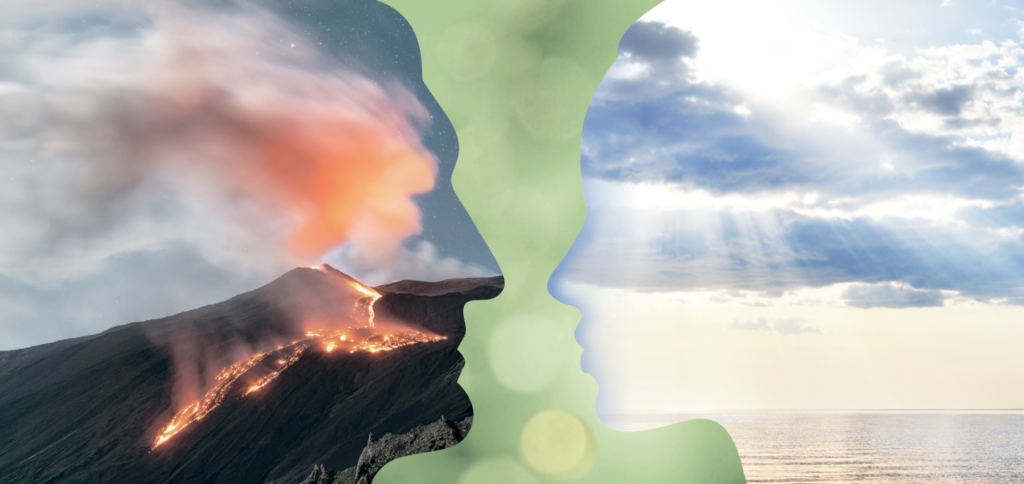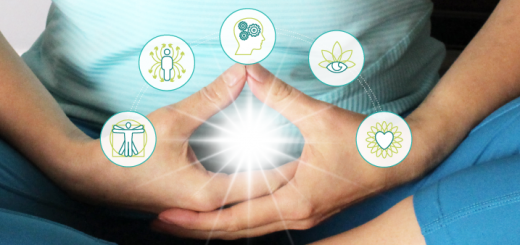Energy, light, and matter within the human body: The three doshas and their main qualities
0Last week we established that both Western science and Eastern thought (mainly, Samkhya philosophy) consider energy, matter, and light to be the building blocks of the Universe. Samkhya philosophy also states that those three main forces appear in different proportional quantities in everything that exists, including the human body and mind. Within our bodies, energy is the origin of life force, the breath of life that animates our physical bodies; it is the most powerful of all forces. Light is the origin of the mind with its ability to know, understand, and discern. Matter forms the foundation of the physical body that gives us substance and shape.
According to Ayurveda, three main forces further work through the five elements.
- Energy works through the air element and moves like the wind. It is very active and stimulates all things into motion. It travels through space, which is not empty but contains invisible energies that can be harnessed, like solar energy. The nerve impulses in the body, the atmospheric forces in nature, and various other energy currents are all examples of air/space energy.
- Light force manifests as the element of fire. Fire transforms, illuminates, and heats things, showing up as the light of distant galaxies, or the light of intelligence within us, as heat produced by our bodies, or as our digestive powers that transform matter (food) into energy. Since fire cannot exist in our bodies in its original form, it is contained within the oily or acidic medium (like stomach acid, for example). That is why within the body, light shows up as a combination of fire and water elements.
- Matter is dominated by the element of water (both on the planet and within our bodies). All life came out of the water, and no life can exist without it. A watery or cohesive force holds solid things together, much like mixing water with flour enables you to make dough. That is why matter often manifests as a combination of water and earth elements.
When these elements are present within living breathing creatures, they are animated with life force or prana, becoming doshas.
- Energy (Air/Space) + Prana = Vata dosha (with main qualities of mobility and expression)
- Light (Fire/Water) + Prana = Pitta dosha (with main qualities of heat, intensity, and transformation).
- Matter (Water/Earth) + Prana = Kapha dosha (with main qualities of cohesion and stability).

Each of us has some combination of those qualities within us, with one or two doshas often playing a more dominant role. Our dominant doshas manifest in our physical appearance, physiology, susceptibility to certain diseases, temperament, and personality. For example, a stereotypical grandma is often portrayed as a kapha-dominant type with her rounded and soft body, comforting hugs, deeply caring nature, and a kitchen full of delicious cookies. She embodies the matriarch of the family, who gives it cohesion and stability. We, of course, know that grandmas come in all shapes and body types, with a variety of personalities, temperaments, and cooking preferences. Below is a list of all three doshas, their main qualities, and how those qualities tend to manifest in the human body.
 Vata is the motivating power behind two other doshas that propels them into action. Vata is in constant motion; it governs sensory, emotional, and mental balance and promotes mental adaptability and comprehension. It gives us the positive qualities of creativity, enthusiasm, and agility that propel us to move forward and accomplish our goals in life.
Vata is the motivating power behind two other doshas that propels them into action. Vata is in constant motion; it governs sensory, emotional, and mental balance and promotes mental adaptability and comprehension. It gives us the positive qualities of creativity, enthusiasm, and agility that propel us to move forward and accomplish our goals in life.
Main qualities: Dry, light, cold, clear, mobile, subtle, rough
|
PHYSICAL ATTRIBUTES
|
PHYSIOLOGY
|
TEMPERAMENT AND PERSONALITY
|
 Pitta is responsible for all forms of digestion and transformation within the body, from the cellular level to our digestive tract to our ability to process our experiences and grow from them. It gives us the positive qualities of intelligence, courage, vitality, and decisiveness that motivate us to accomplish our goals.
Pitta is responsible for all forms of digestion and transformation within the body, from the cellular level to our digestive tract to our ability to process our experiences and grow from them. It gives us the positive qualities of intelligence, courage, vitality, and decisiveness that motivate us to accomplish our goals.
Main qualities: Oily, sharp, hot, light, liquid
|
PHYSICAL ATTRIBUTES
|
PHYSIOLOGY
|
TEMPERAMENT AND PERSONALITY
|
 Kapha is responsible for stability and structural integrity; it serves as a container for other doshas. Kapha provides cohesion and cushions the entire body, from the skin to mucus lining, fat tissue, and lymph flow. Kapha gives us love and caring, devotion and faith that enhance our inner sense of harmony and connect us to our families and communities.
Kapha is responsible for stability and structural integrity; it serves as a container for other doshas. Kapha provides cohesion and cushions the entire body, from the skin to mucus lining, fat tissue, and lymph flow. Kapha gives us love and caring, devotion and faith that enhance our inner sense of harmony and connect us to our families and communities.
Main qualities: Oily, heavy, cold, cloudy, dense, slow, soft, slimy, static, hard
|
PHYSICAL ATTRIBUTES
|
PHYSIOLOGY
|
TEMPERAMENT AND PERSONALITY
|
Would you like to know your dominant dosha(s)? Fill out this simple questionnaire to get a better insight into your constitutional type. Sequence wiz members can modify this questionnaire any way they like and use it with their students (learn more about Sequence Wiz membership >)
Understanding your unique proportional combination of doshas is useful on multiple levels. It can help you better understand why you do things the way you do them, notice the earliest signs of disease or imbalance, and identify factors in your lifestyle and environment that contribute to your physical and mental health challenges. Over the next few weeks, we will discuss how our environment and habitual activities balance out or aggravate our doshas and what kind of yoga practices we can use to correct the imbalances – tune in!
[jetpack_subscription_form]
References
- Yoga and Ayurveda: Self-Healing and Self-Realization by David Frawley (affiliate link)
- The Chemistry of Joy: A Three-Step Program for Overcoming Depression Through Western Science and Eastern Wisdom by H. Emmons, M.D. (affiliate link)




















